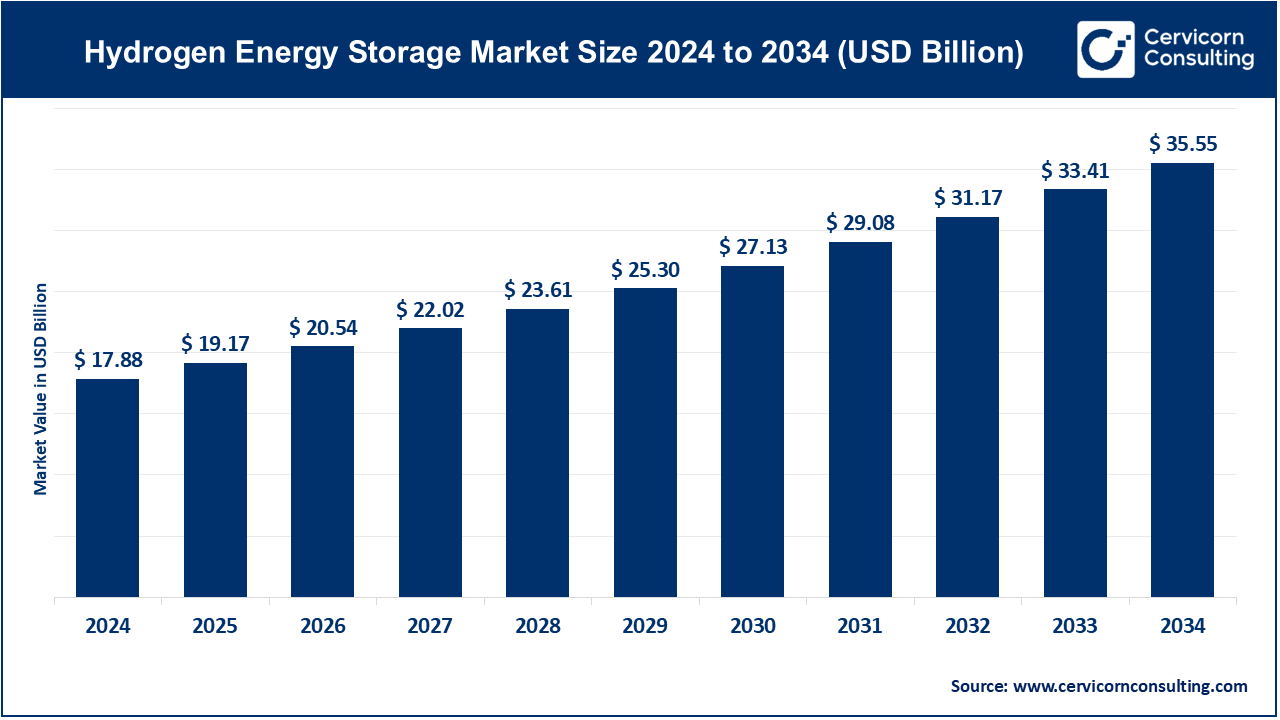Hydrogen Energy Storage Market Size
The global hydrogen energy storage market was valued at USD 17.88 billion in 2024 and is projected to reach USD 35.55 billion by 2034, growing at a CAGR of 7.19% from 2025 to 2034.
What is the Hydrogen Energy Storage Market?
The hydrogen energy storage market encompasses the production, storage, and distribution of hydrogen as an energy carrier. Hydrogen can be stored in various forms, including compressed gas, liquid hydrogen, and chemical compounds, enabling it to act as a versatile solution for energy storage. Its applications span power generation, industrial processes, transportation, and backup energy systems.
The market’s significance lies in its role in the global energy transition: it helps store excess renewable energy, enhances grid stability, and decarbonizes hard-to-electrify sectors like heavy industry and long-haul transportation. As nations aim to meet net-zero emissions targets, hydrogen energy storage emerges as a critical component of sustainable energy infrastructure.
Market Trends
The hydrogen energy storage market is shaped by several key trends:
-
Green Hydrogen Expansion
A major trend is the adoption of green hydrogen produced through electrolysis using renewable energy. This reduces carbon emissions and attracts investments in large-scale hydrogen storage and production projects. -
Technological Advancements
Innovations in electrolyzers, fuel cells, and storage materials are improving efficiency and reducing costs. Solid-state storage, compressed hydrogen, and liquefaction technologies are gaining prominence as scalable storage solutions. -
Integration with Renewable Energy
Hydrogen storage systems are increasingly coupled with wind and solar farms to balance energy supply and demand. This integration addresses intermittency issues and enhances grid resilience. -
Industrial Adoption
Hydrogen storage is growing rapidly in industrial applications, particularly in refining, chemical production, and metallurgy, where it provides a sustainable alternative to conventional energy sources. -
Policy-Driven Growth
Governments are promoting hydrogen adoption through subsidies, tax incentives, and strategic funding, fostering collaborations between private companies and research institutions.
Market Dynamics
Drivers:
-
Increasing renewable energy deployment creates demand for efficient storage solutions.
-
Government incentives and strategic policies support hydrogen production and storage infrastructure.
-
Technological progress in electrolyzers and fuel cells reduces costs and improves scalability.
-
Growing need to decarbonize industries and transport sectors drives adoption.
Restraints:
-
High capital expenditure and infrastructure costs remain a barrier.
-
Lack of standardized storage regulations and safety concerns limit rapid expansion.
Opportunities:
-
Expansion of green hydrogen projects in emerging markets offers growth potential.
-
Integration with energy-intensive sectors and mobility solutions creates new applications.
-
Strategic partnerships and M&A activity can accelerate market penetration.
Challenges:
-
Energy losses during hydrogen conversion and storage efficiency remain technological hurdles.
-
Developing a global hydrogen supply chain is complex due to logistics and regional infrastructure gaps.
Regional Analysis
-
Asia-Pacific: The largest regional market, led by Japan, South Korea, and China, driven by industrial adoption and government hydrogen strategies.
-
Europe: Strong growth fueled by the EU Hydrogen Strategy and large-scale infrastructure projects. Countries like Germany and the Netherlands are investing in hydrogen valleys and storage networks.
-
North America: Growth supported by government funding and initiatives like the U.S. Hydrogen Shot, focusing on cost reduction and industrial deployment.
-
Middle East & Africa: Emerging market potential due to abundant renewable resources, with projects like Saudi Arabia’s NEOM green hydrogen initiative.
-
Latin America: Opportunities in countries like Chile and Brazil, leveraging renewable energy for competitive green hydrogen production.
Recent Developments
-
Expansion of hydrogen hubs and production facilities worldwide.
-
Partnerships and joint ventures between major energy companies and technology providers to scale hydrogen storage infrastructure.
-
Innovations in solid-state hydrogen storage and electrolyzer efficiency.
-
Regulatory developments supporting green hydrogen adoption and incentivizing industrial and mobility applications.
-
Growing investment in hydrogen storage for fuel cell vehicles and industrial decarbonization, aligning with regional net-zero commitments.
Conclusion
The hydrogen energy storage market is poised for substantial growth due to technological advancements, supportive policies, and increasing demand from industrial and mobility sectors. With its critical role in enabling a low-carbon energy future, hydrogen storage is set to become a cornerstone of global energy transition efforts, providing scalable, flexible, and sustainable solutions across regions and industries.
For more detailed insights and data, you can visit the original source: Cervicorn Consulting
Read: Dental Service Organization Market Regional Analysis, Trends, and Strategic Developments by 2034

